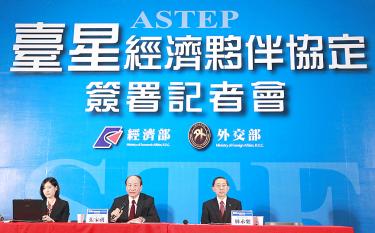Taiwan yesterday signed a far-reaching free-trade agreement (FTA) with Singapore — the first of its kind with a Southeast Asian country — in a move the government said would boost the nation’s efforts to pursue further economic engagement with trading partners bilaterally and multilaterally.
“This is a milestone achievement for Taiwan’s progress toward economic liberalization and our participation in regional economic integration,” Minister of Economic Affairs Chang Chia-juch (張家祝) told a press conference at 11am in Taipei.
Minister of Foreign Affairs David Lin (林永樂) said the agreement demonstrated Taiwan’s commitment to trade and investment liberalization to the global community.
The agreement “serves as an example” for Taiwan’s negotiation with other countries to sign economic cooperation agreements, Lin said.
“It could also trigger a domino effect” by encouraging other countries to open talks with Taiwan on similar trade accords, Lin added.
The pact — called the Agreement between Singapore and the Separate Customs Territory of Taiwan, Penghu, Kinmen and Matsu on Economic Partnership (ASTEP) — was signed by Representative to Singapore Fadah Hsieh (謝發達) and Singaporean Trade Representative to Taiwan Calvin Eu at a ceremony held at 9:30am in Singapore.
With Beijing’s insistence that FTAs can only be concluded among sovereign states, Taiwan has to conclude FTA-like agreements under a different name, such as the Agreement between New Zealand and the Separate Customs Territory of Taiwan, Penghu, Kinmen and Matsu on Economic Cooperation signed in August.
The exceptions are the four FTAs that Taiwan has with five diplomatic allies in Central America — Panama, Guatemala, Nicaragua, El Salvador and Honduras.
Billed by the government as a comprehensive, “high-standard” and “high-quality” trade agreement, the ASTEP contains 17 chapters, covering market access conditions for trade in goods, cross-border trade in services, government procurement and e-commerce; issues related to trade rules — technical barriers to trade, rules of origin, foreign investment, competition policies, trade remedies, customs procedures, sanitary and phytosanitary measures, and transparency; cooperation in intellectual property protection; and dispute settlement provisions.
Taiwan will remove 99.48 percent of its tariff lines within 15 years at the latest, with the exception of 40 agricultural products, including rice, mangoes, garlic, shiitake mushrooms, red beans, shelled ground-nuts and liquid milk.
Once the agreement takes effect, expected early next year, Taiwan will provide Singapore immediate tariff-free access to 65.97 percent of its agricultural products and 87.39 percent of its industrial products, while duties on the rest of the products will be reduced in three stages over a 15-year period.
The tariff cuts will have a limited impact on Taiwan’s agricultural sector because Singapore is not an agriculture-based economy, he said.
Chang added that throughout the two-and-a-half years of negotiations, Taiwan pressed for a longer tariff phase-out period to give less-competitive, domestic-oriented industries, such as auto parts, engines, motorcycles, towels and cotton clothing, time to adjust.
In return, Singapore, which has a very open trading regime that levies tariffs on only six beverage products, extended zero tariffs to all imports from Taiwan.
Both countries also agreed to adopt a “negative list” — as opposed to the “positive list” used in the WTO’s General Agreement on Trade in Services — to provide greater market access to investors from the other country. Under this set-up, the two countries agreed to open all their service sectors, unless specifically excluded by each country in an annex to the agreement.
Taiwan’s negative investment list covers 30 sectors in transportation, telecommunication and professional services, while Singapore has 35 sectors on its list related to healthcare and transportation, among others.
Both countries agreed to go beyond their respective WTO commitments in certain service sectors, including research and development service, general engineering and Type I telecommunications enterprises, while applying their commitments under the WTO to the finance industry under the bilateral agreement.
The agreement is expected to add US$701 million to Taiwan’s GDP over the next 15 years, boosting domestic output by NT$42.1 billion (US$1.43 billion) and creating 6,154 jobs, Chang said, citing a study conducted by the Chung-Hua Institution for Economic Research (中華經濟研究院).
Lin said that aside from signing FTAs with its main trade partners, Taiwan’s ultimate goal is to participate in regional economic integration through agreements such as the Trans-Pacific Partnership (TPP) and the Regional Comprehensive Economic Partnership (RCEP) — both possible pathways to the formation of an Asia-Pacific free-trade area.
“We will contact each member involved in TPP and RCEP negotiations and conclude agreements with them one by one,” Lin said.
Taiwan has completed feasibility studies on signing FTA-like pacts with India and Indonesia. Another one on trade with the Philippines is expected to be completed in the near future, Lin said.
Source: Taipei Times - 2013/11/08





















